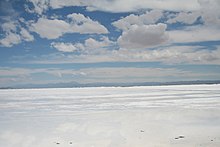Salinas Grandes
The Salinas Grandes is the name of three salt deserts (salars) in Argentina :
- in the provinces of Catamarca, Córdoba, La Rioja and Santiago del Estero, 30 ° 0 ′ S , 65 ° 0 ′ W
- in the provinces of Salta and Jujuy ( Salinas Grandes del Noroeste ), 24 ° 0 ′ S , 66 ° 0 ′ W
- in the provinces of Buenos Aires and La Pampa ( Salinas Grandes del Sur ), 39 ° 0 ′ S , 63 ° 0 ′ W
Salinas Grandes
The Salinas Grandes ( 30 ° 0 ' S , 65 ° 0' W ) is located in a non-draining sink on the border of the provinces of Catamarca ( La Paz Department ), Cordoba ( Cruz del Eje Department , Ischilín Department , Departamento Minas , sobremonte department and tulumba department ), La Rioja ( Departamento Chamical ) and Santiago del Estero ( Departamento Ojo de Agua ). The average extent of the strongly fluctuating water area is 6,000 km².
Salinas Grandes del Noroeste
The Salinas Grandes del Noroeste ( 24 ° 0 ′ S , 66 ° 0 ′ W ) are located in the border area of the provinces Salta ( Departamento La Poma ) and Jujuy ( Departamento Cochinoca and Departamento Tumbaya ) in a high valley at about 3,450 m above sea level. The approximately 212 km² large lake was created 5 to 10 million years ago in the course of tectonic changes on the eastern slope of the Andes . As a result, several rivers, such as the Rio del San Antonio de los Cobres, the Rio de los Burros and the Rio Talao, lost their outflow and are now the main sources of the Salinas Grandes and the more northerly Laguna de Guayatayoc . The 30 centimeter thick layer of salt , mostly consisting of sodium chloride , is being mined near an artificial island on the dam of the Ruta Nacional 52 .
Salinas Grandes del Sur
The Salinas Grandes del Sur ( 39 ° 0 ′ S , 63 ° 0 ′ W ) is only about 45 km southwest of the provincial capital Bahía Blanca ; they are a number of tectonically caused smaller depressions in the border area of the provinces of Buenos Aires and La Pampa near the Río Colorado , which filled with salt after flooding during the dry season. They were already commercially exploited in the 18th and 19th centuries, and transport to Buenos Aires was problem-free and made it possible, for example, to salt meat. The important production sites are located in the Departamento Puan , in Departamento Adolfo Alsina and Departamento Villarino , where it reaches a depth of 61 meters below sea level.
Individual evidence
- ↑ Conrado Juan Rosacher - Áreas Naturales Protegidas. Salinas Grandes de Córdoba, Aspectos Ambientales. September 2002. ( Page no longer available , search in web archives ) Info: The link was automatically marked as defective. Please check the link according to the instructions and then remove this notice. (PDF; 956 kB)
- ↑ Martin Iriondo (2006). “Introducción a la Geología”, Editorial Brujas 3º Edición, Argentina. ISBN 978-987-591-061-4
- ^ Instituto Argentino de Investigaciones de las Zonas Aridas (IADIZA-CONICET) (2007) “Ambientes de las Salinas Grandes de Catamarca, Argentina”.

